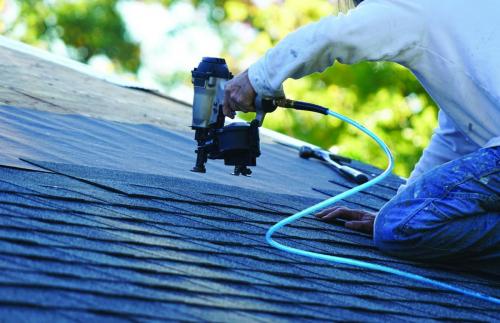
Roofer using an efficient pneumatic nail gun operating from a small gasoline powered or electric powered air compressor.
Reciprocating/piston air compressors have many moving parts and regular maintenance is an essential practice. This ensures all compressor components function at peak efficiency as well as for preventing wear that can ultimately lead to premature failure. The following tips can serve as a guide for safe, reliable, and economical reciprocating compressor operation and maintenance.
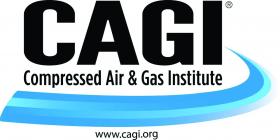
Keeping the Air Compressor Clean
Excess dirt and debris are a major cause of premature compressor failure. Compressor operators play an important role in the preventive maintenance process by watching for the accumulation of dirt during use and removing it as quickly as possible. Simply cleaning or blowing off any dirt or contaminants, using compressed air, on a regularly scheduled and routine basis is a simple and inexpensive way to ensure compressor components are kept clean.
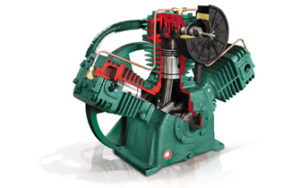
Basic pump of reciprocating air compressor.
Minimizing Vibrations
Vibration is a common issue that can lead to reciprocating compressor failure. Vibration is typically a result of the compressor not being properly secured. Constant vibration will eventually cause compressor parts and components to loosen, leading to parts misalignment, excessive wear on the bearings, and other more serious mechanical problems. Ensure the compressor is tightly secured on a flat surface. Inexpensive vibration pads, when properly installed, can help minimize/eliminate vibration issues.
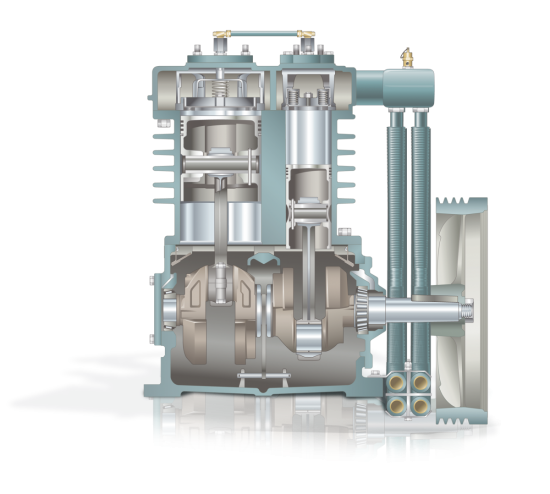
Cutaway of reciprocating air compressor
Changes in Temperature
A sudden spike in temperature during operation is a sign that a compressor is running too hot. If the operator is unable to regulate the temperature, the compressor should be shut down immediately, as running it at high temperatures for an extended period of time will most certainly lead to equipment failure. Temperature spikes could occur when crankcase oil level drops below sufficient levels and/or the compressor has accumulated a buildup of dirt/dust/grime. Additionally, electric drive motors can overheat. Proper bearing greasing per the operator’s manual and keeping the motor clean from debris and dirt can help ensure years of trouble-free service.
Reciprocating Air Compressor Maintenance Checklist (Sample)Daily
Weekly
Monthly
Quarterly
Annually
|
Piston Air Compressor Oil Maintenance
When to add or change reciprocating air compressor oil will depend on factors such as the model type and operating conditions. In general, manufacturers recommend changing the oil on a quarterly basis, but more often with greater use. Exceptions to quarterly oil change intervals exist as some manufacturers offer long-life synthetic lubricants designed for extended life; typically 1-year or 2,000 hours, whichever occurs first. The operator should also regularly monitor the fluid level as part of a sound routine maintenance/equipment inspection process and add oil as necessary. Some reciprocating compressors come equipped with a low oil-level monitoring device, which can prevent damage or premature pump failure from running the compressor on low oil.
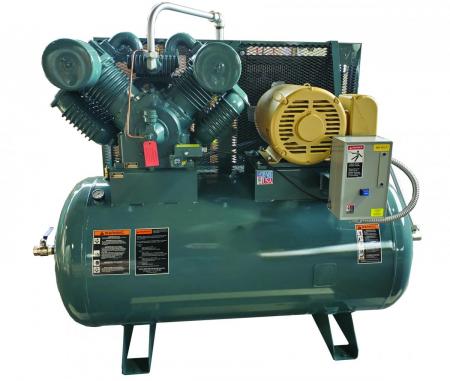
Preventive Maintenance Checks
Regular service helps to ensure your machine and all inline equipment are running at maximum performance. Your business is important, if your reciprocating air compressor shuts down, so does your business. Regular service will also help to identify and head off any potential issues before they cause long term damage. Compressor manufacturers have specific maintenance schedules and maintenance kits they recommend for proper service. Remember, when performing maintenance on equipment, always ensure your unit is off and disconnected from the power source.
Following a regular maintenance schedule will not only reduce service calls, but it will ensure efficient compressor performance and extend the life of the compressor. Below is a sample checklist that can be performed on a daily, weekly, monthly, and annual basis. For specific details on a routine maintenance schedule, follow manufacturer guidelines in the operator’s manual.
| The Compressed Air and Gas Institute (CAGI) is the united voice of the compressed air industry, serving as the unbiased authority on technical, educational, promotional, and other matters that affect compressed air and gas equipment suppliers and their customers. CAGI educational resources include e-learning coursework, selection guides, videos and the Compressed Air & Gas Handbook.
The Reciprocating Compressor Section consists of the following member companies:
Visit www.cagi.org. |
All photos are courtesy of the Compressed Air and Gas Institute.
For more information, contact the Compressed Air & Gas Institute, tel: (216) 241-7333, email: cagi@cagi.org, visit www.cagi.org or https://www.linkedin.com/company/cagi/.
To read more Air Compressor Technology articles, visit www.airbestpractices.com/technology/air-compressors.




